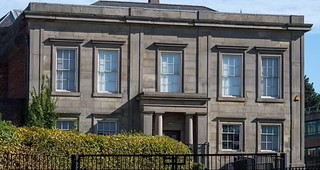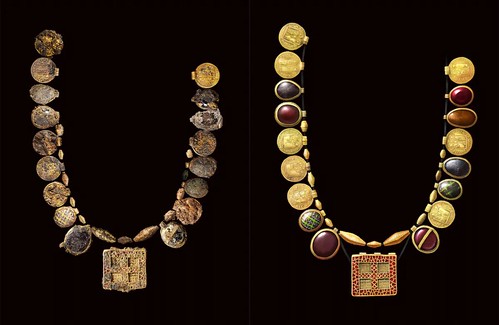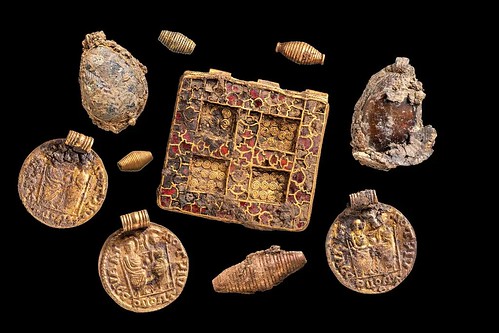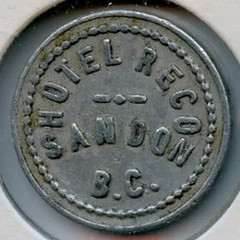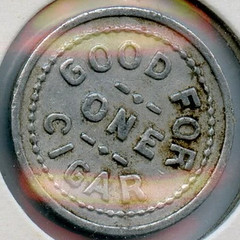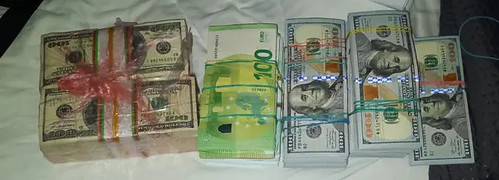
PREV ARTICLE
NEXT ARTICLE
FULL ISSUE
PREV FULL ISSUE
V25 2022 INDEX E-SYLUM ARCHIVE LOOSE CHANGE: DECEMBER 11, 2022Here are some additional items in the media this week that may be of interest. -Editor Despite the headline "Roman Treasure Stolen from British Museum...", the coins were stolen from a regional museum in Preston where they had been deposited before being shipped to the British Museum for review. -Editor
The trove includes 28 Roman silver coins and a silver ingot unearthed earlier this year in Rutland. The artifacts were given to the museum by the two metal detectorists who found them as required by law.
To read the complete articles, see:
Greg Cohen passed along this Washington Post story about the find of an amazing Anglo-Saxon necklace adorned with eight Roman gold coins. Thanks! Great item. -Editor Left: A reconstructed necklace of gold and semiprecious stones, dating to A.D. 630-670, was found at a burial site near Northampton in England. Right: A rendering of what the necklace is believed to have looked like then. (Courtesy of Museum of London Archaeology) A 1,300-year-old necklace beaded with gold and semiprecious stones has been discovered in an early Anglo-Saxon burial site under a construction project in central England. The location is being hailed as the most significant female burial site from the era discovered in Britain.
The jewelry piece, dating to between 630 and 670 AD, was discovered at a gravesite near Northampton this year, and archaeologists announced the details of the find Tuesday. The necklace contains 30 trinkets, including four garnets set in gold, five glass pendants, eight Roman gold coins, and 12 beads, all set around an intricate rectangular pendant marked with a cross motif.
Experts have hailed the find as particularly significant evidence of the role played by elite women at the time.
To read the complete article, see:
Greg also found a second article from the New York Times. This one has a better image of some coins. -Editor
To read the earlier E-Sylum article, see:
A Catherine the Great Seal Not quite numismatic but related are seals used to mark official documents. A great item "found in a biscuit tin." -Editor 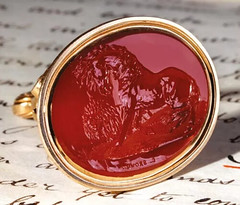 Charles Brown (1749-95) and his brother William were gem-workers, both exhibiting at the Royal Academy. From 1786-95 they received numerous commissions from the court of Catherine II, Empress of Russia.
Charles Brown (1749-95) and his brother William were gem-workers, both exhibiting at the Royal Academy. From 1786-95 they received numerous commissions from the court of Catherine II, Empress of Russia.
Approximately two hundred cameos and intaglios remain in the Hermitage, St Petersburg. The seal pictured here, on offer at Ilkley saleroom Hartleys on December 7, is one of two sold directly to Catherine. Hartleys says ‘an outside expert has suggested that this may be the original stone and the one in the Hermitage was the second to be carved'. It is a cornelian oval seal, intaglio carved with George Stubbs' (1724-1806) famous work Horse Frightened by a Lion (1770), and is signed in the stone C. Brown F. In a gold scroll mount with plain frame, 4 x 3cm overall, it has been owned by a private family for at least four generations – but found by a valuer ‘in a biscuit tin with assorted bits and bobs, so mucky you could hardly tell what it was'.
To read the complete lot description, see:
CoinsWeekly published an article about coin dealer Robert E. White. -Editor
To read the complete article, see:
Mainstream media rarely get numismatic details correct, but it's still nice to see them covering the topic. A "Good For" token from a Vancouver ghost town inspired a local newspaper story. -Editor A rare token for one free cigar at a long-defunct hotel in a B.C. ghost town has sold for more than $600. The small token — marked Hotel Reco Sandon B.C. on the front and Good For One Cigar on the back — was listed on E-bay for 99 cents on Nov. 19. Over the next five days there were 16 bids. One bidder started at $155 and ended up making a final offer of $600 before being outbid for $610 at the last minute by someone who had made no earlier bids. Sandon is one of B.C.'s well-known ghost towns, located halfway between New Denver and Kaslo off Highway 31A in the West Kootenay. It was built to service a short-lived but lucrative silver boom in the deep and high valley renowned for its heavy annual snowfall. The community prospered from 1890 to 1900, then died off before having another boom during the First World War. The first hotel was registered in May 1893 and within a few years Sandon had 24 hotels, two dozen saloons, two rail lines and three breweries with around 5,000 permanent residents. There was also a curling arena, hockey rink and even a ski hill.
To read the complete article, see:
The Security Service of Ukraine (SSU) has completed counterintelligence operations at premises of the Ukrainian Orthodox Church of the Moscow Patriarchate (UOC-MP) in Kharkiv Oblast. Law enforcement officers found libraries containing pro-Kremlin literature, materials praising the aggressor country, and a large amount of cash in various currencies, including Russian roubles, on the territory of the diocese. Even Russian-issued field rations were being stored in one of the churches. A monk holding a Russian passport was also discovered there. The security forces are now investigating whether he was involved in intelligence and subversive activities for the Russian secret services.
To read the complete article, see:
Wayne Homren, Editor The Numismatic Bibliomania Society is a non-profit organization promoting numismatic literature. See our web site at coinbooks.org. To submit items for publication in The E-Sylum, write to the Editor at this address: whomren@gmail.com To subscribe go to: https://my.binhost.com/lists/listinfo/esylum All Rights Reserved. NBS Home Page Contact the NBS webmaster 
|
